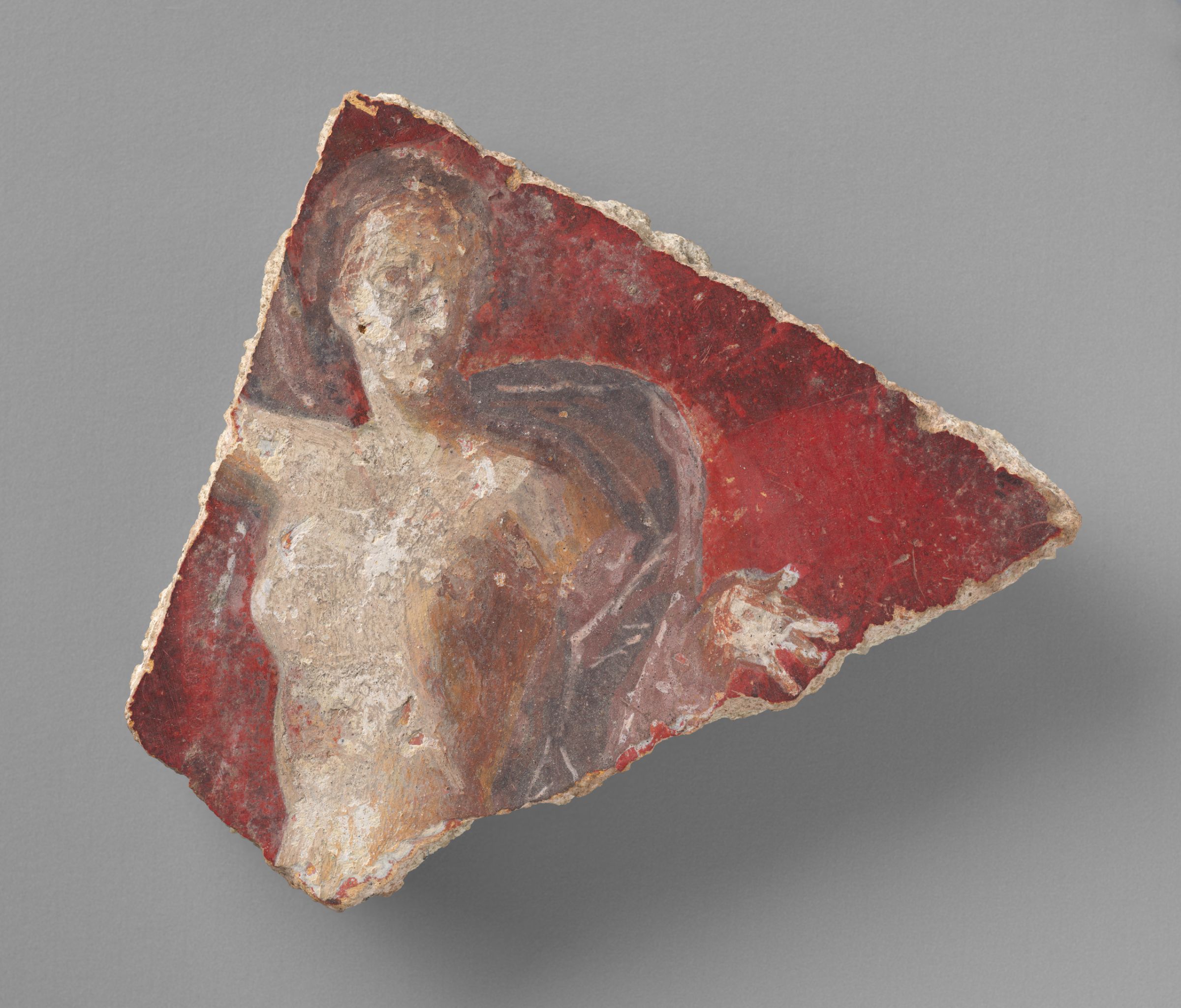2012.1.131: Phallus with Greek Inscription to Hermes
SculptureShaped like an upside-down bell, the topmost edge is flat and a large set of testicles and a rudimentary penis with a round defined head extends downward. The upper half of the object has symbols which look like letters carved in three lines. The top row looks like E P (unknown) H C, the second row looks like B E W Y, and the third row looks like V I C T W. There are no other carved details and the surface is a brown and beige mottled color all over.
Gallery Text
Model body parts were offered at healing sanctuaries to thank a god for healing the limb or organ depicted. Large deposits of these anatomical votives include detailed representations of internal organs such as uteruses and intestines. Unlike the terracotta eye and foot, the copper alloy phallus would have been riveted to something, perhaps in a home, for good luck. Romans often wore amulets in the shape of a phallus to ward off the "evil eye."
Identification and Creation
- Object Number
- 2012.1.131
- Title
- Phallus with Greek Inscription to Hermes
- Classification
- Sculpture
- Work Type
- sculpture
- Date
- 2nd-3rd century CE
- Places
- Creation Place: Ancient & Byzantine World
- Period
- Roman Imperial period
- Culture
- Roman
- Persistent Link
- https://hvrd.art/o/191415
Location
- Location
-
Level 3, Room 3700, Ancient Mediterranean and Middle Eastern Art, Roman Art
View this object's location on our interactive map
Physical Descriptions
- Medium
- Mixed copper alloy
- Technique
- Cast, lost-wax process
- Dimensions
- 6.2 x 5 x 2.7 cm (2 7/16 x 1 15/16 x 1 1/16 in.)
- Technical Details
-
Chemical Composition: XRF data from Artax 1
Alloy: Mixed Copper Alloy
Alloying Elements: copper, tin, lead, zinc
Other Elements: iron
K. Eremin, January 2014Technical Observations: The patina is dark brown with lighter burial accretions. The surface is very well preserved, and no green or red corrosion products are present. The two iron mounting pins at the top, however, are completely mineralized. This and much evidence of fine wear are evidence of significant age in spite of the absence of green and red corrosion products.
The phallus was cast by the lost-wax process, probably from a model fashion directly in wax. The slightly crudely written inscription is fluid looking under magnification and was probably incised directly in the wax model. A third mounting hole at the bottom shows no iron corrosion products and was probably not used.
Henry Lie (submitted 2011) - Inscriptions and Marks
-
-
inscription: in Greek, in three lines:
ἙΡΜΗϹ
ΘΕWV
ΝΙϹΤW
-
inscription: in Greek, in three lines:
Provenance
- Recorded Ownership History
-
[Sotheby's Antiquities Auction, New York, November 21-22, 1985], sold; to The Alice Corinne McDaniel Collection, Department of the Classics, Harvard University (1985-2012), transfer; to the Harvard Art Museums, 2012.
Note: Sotheby Sale 5398, Lot 267.
Acquisition and Rights
- Credit Line
- Harvard Art Museums/Arthur M. Sackler Museum, Transfer from the Alice Corinne McDaniel Collection, Department of the Classics, Harvard University
- Accession Year
- 2012
- Object Number
- 2012.1.131
- Division
- Asian and Mediterranean Art
- Contact
- am_asianmediterranean@harvard.edu
- Permissions
-
The Harvard Art Museums encourage the use of images found on this website for personal, noncommercial use, including educational and scholarly purposes. To request a higher resolution file of this image, please submit an online request.
Descriptions
Published Catalogue Text: Ancient Mediterranean and Near Eastern Bronzes at the Harvard Art Museums
This depiction of male pubis, penis, and scrotum is hollow on the back and would have been attached to something via the iron rivets in the corner and the third attachment hole located in the bottom of the scrotum (1). The flaccid penis is bulbous closer to the body and tapers toward the circular tip; there is no indication of pubic hair. Located above the penis, the simple and slightly irregular incised lettering reads: “To Hermes the highest of the gods.” The inscription is in three lines.
NOTES:
1. Compare British Museum, London, inv. no. 1814,0704.1256 (votive offering); and Staatliche Museen zu Berlin, inv. nos. Fr. 1341 (with nail hole) and Misc. 7464 (applique with attachment on back).
Lisa M. Anderson
Exhibition History
- 32Q: 3700 Roman, Harvard Art Museums, 11/16/2014 - 01/01/2050
Subjects and Contexts
- Roman Domestic Art
- Ancient Bronzes
- Google Art Project
Related Digital Tours
Verification Level
This record has been reviewed by the curatorial staff but may be incomplete. Our records are frequently revised and enhanced. For more information please contact the Division of Asian and Mediterranean Art at am_asianmediterranean@harvard.edu
